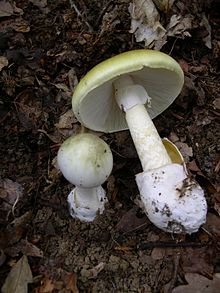Amanita
| Amanita | |
|---|---|

| |
| A. muscaria | |
| Scientific classification | |
| Kingdom: | |
| Phylum: | |
| Class: | |
| Family: | |
| Genus: | Amanita
|

The genus Amanita contains a species of basidiomycete mushrooms, including some of the most toxic known. It is found worldwide.
This genus is responsible for approximately 95% of the fatalities resulting from mushroom poisoning, with the death cap accounting for about 50% on its own. The most potent toxin present in these mushrooms is amanitin, of which at least eight versions are known.[1][2]
Species[change | change source]
- Amanita abietum
- Amanita abrupta
- Amanita albocreata
- Amanita bisporigera
- Amanita caesarea
- Amanita jacksoni
- Amanita muscaria
- Amanita ocreata
- Amanita pantherina
- Amanita phalloides
- Amanita verna
- Amanita virosa
Notable species[change | change source]
Fly agaric[change | change source]
Amanita muscaria, commonly known as the fly agaric, is a psychoactive fungus. It is known as the fly agaric for its ability to kill houseflies when combined with milk. The reason for this is that flies are attracted to the milk because it is so sweet. When they drink the milk they feel the effects of the mushroom and begin to get intoxicated.
Death cap[change | change source]
Amanita phalloides, commonly known as the death cap, is a deadly poisonous fungus, one of many in the genus Amanita. Widely distributed across Europe, A. phalloides forms ectomycorrhizas with various broadleaved trees. In some cases, death cap has been accidentally introduced to new regions with the cultivation of non-native species of oak, chestnut, and pine. The large fruiting bodies (mushrooms) appear in summer and autumn; the caps are generally greenish in color, with a white stipe (stem) and gills (underneath the cap).
One mushroom, if eaten, may destroy the liver and cause death. There is no antidote.[3]p211
Toxins[change | change source]
Their major toxic mechanism is the inhibition of RNA polymerase II, a vital enzyme in the synthesis of messenger RNA (mRNA), microRNA (miRNA), and small nuclear RNA (snRNA). Without mRNA, essential protein synthesis, and hence cell metabolism, grind to a halt and the cell dies.[4]
The liver is the organ most affected, because it is the organ which is first encountered after absorption in the gastrointestinal tract. Other organs, especially the kidneys, are susceptible.[3]p217 The RNA polymerase of Amanita phalloides is insensitive to the effects of amatoxins, so the mushroom does not poison itself.[5]
References[change | change source]
- ↑ North, Pamela Mildred 1967. Poisonous plants and fungi in color. London: Blandford Press.
- ↑ Bresinsky A. & Besl H. 1990. A colour atlas of poisonous fungi. Wolfe Publishing, pp. 26–9. ISBN 0-7234-1576-5
- ↑ 3.0 3.1 Benjamin, Denis R. 1995. Mushrooms: poisons and panaceas — a handbook for naturalists, mycologists and physicians. Freeman, New York. ISBN 0-7167-2600-9
- ↑ Karlson-Stiber C, Persson H (2003). "Cytotoxic fungi - an overview". Toxicon. 42 (4): 339–49. doi:10.1016/S0041-0101(03)00238-1. PMID 14505933.
- ↑ Horgen, Paul A.; Vaisius, Allan C.; Ammirati, Joseph F. (1978). "The insensitivity of mushroom nuclear RNA polymerase activity to inhibition by amatoxins". Archives of Microbiology. 118 (3): 317–9. doi:10.1007/BF00429124. PMID 567964. S2CID 37127957.
